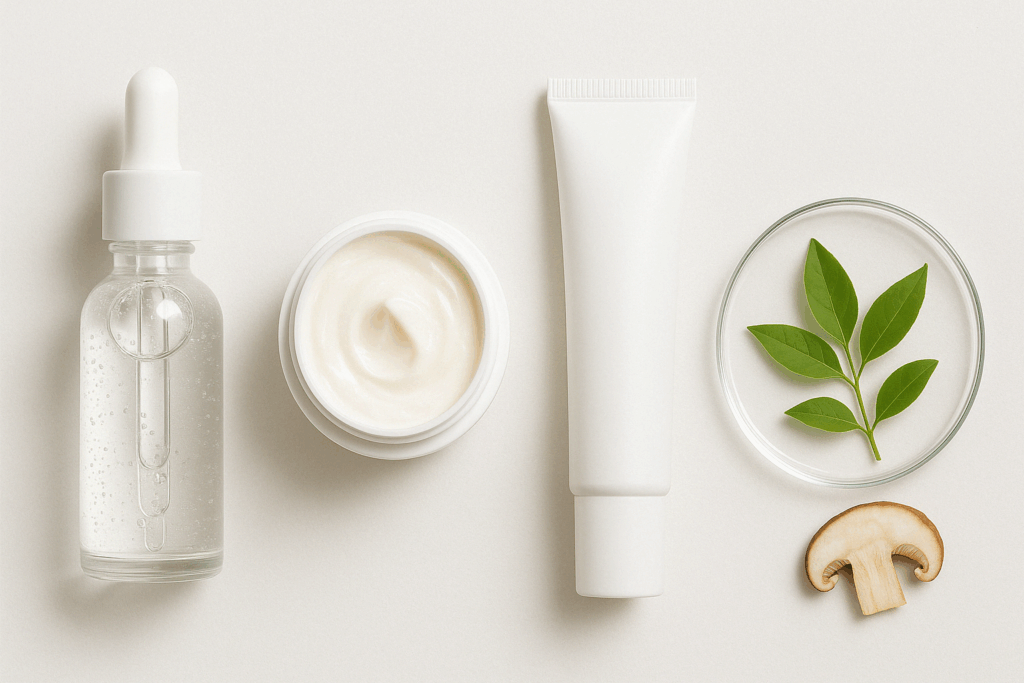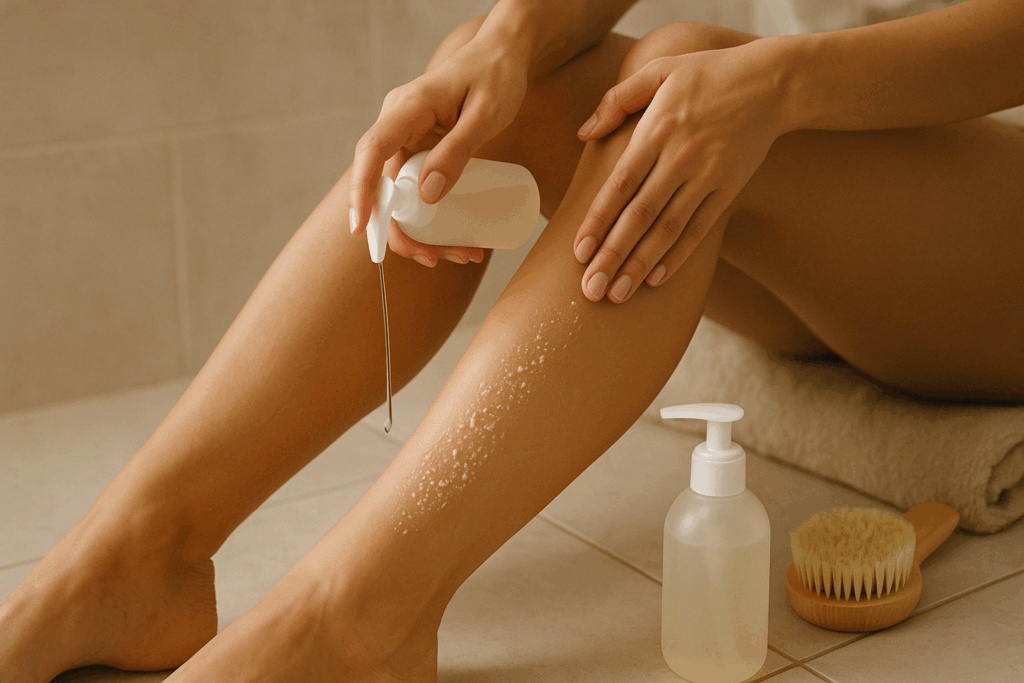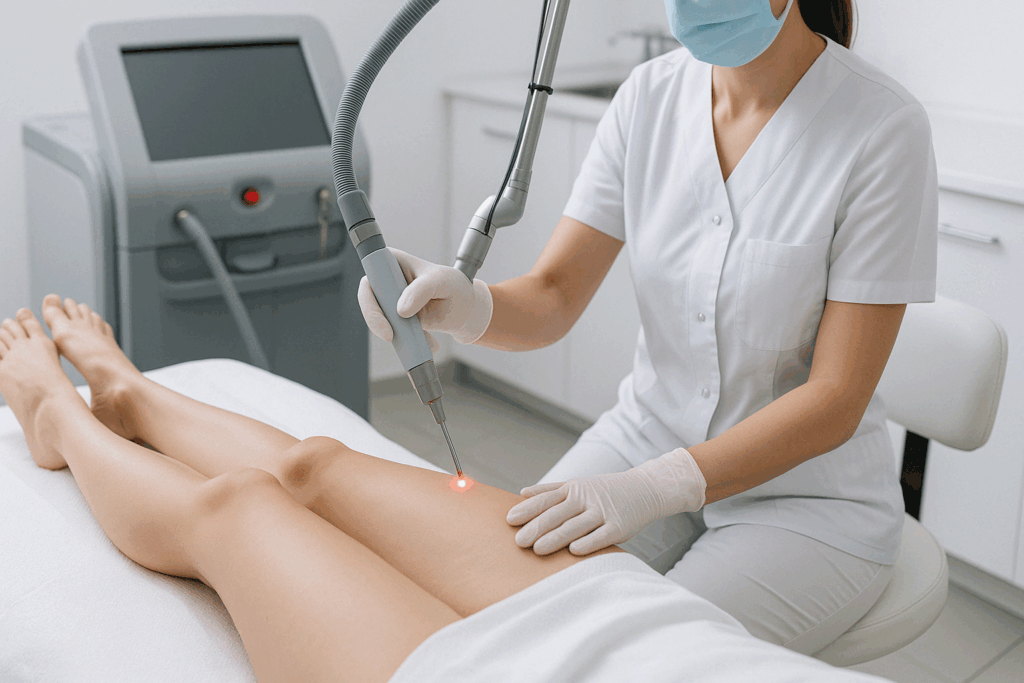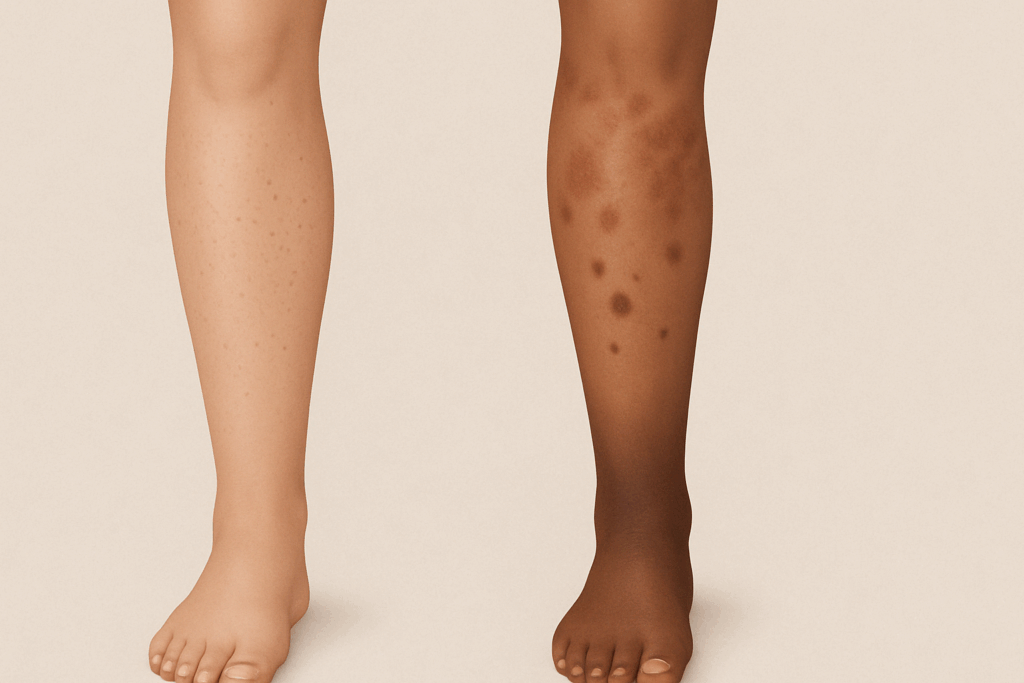Hyperpigmentation on the legs can be a frustrating and confidence-lowering experience, especially when it persists despite diligent skincare routines. Whether caused by sun exposure, scarring from insect bites or shaving, or underlying medical conditions, these dark marks often resist over-the-counter remedies and may leave individuals wondering where to turn. Fortunately, modern dermatology and evidence-based skincare have advanced well beyond one-size-fits-all solutions. Understanding how to get rid of dark spots on legs requires not only patience but a comprehensive approach that combines prevention, scientifically-backed treatments, and personalized skincare practices. In this guide, we explore the physiological causes of hyperpigmentation, discuss clinically supported treatment options, and highlight strategies to remove dark spots and patches on the legs safely and effectively.
You may also like: How to Choose Skin Care for Fine Lines: Evidence-Based Tips for Healthier, Younger-Looking Skin

Understanding Why Dark Spots Appear on the Legs
To know how to remove the dark spots on legs, it is essential to first understand what causes them in the first place. Hyperpigmentation is the broad medical term for patches of skin that become darker than the surrounding area. On the legs, this darkening often results from post-inflammatory hyperpigmentation (PIH), a condition that occurs when inflammation or injury—like shaving cuts, folliculitis, bug bites, or acne—triggers an overproduction of melanin. This melanin becomes concentrated in specific spots, leading to dark patches that linger long after the original issue has healed.
Sun exposure is another primary contributor. Ultraviolet (UV) radiation stimulates melanocytes to produce more pigment, which is the body’s natural attempt to protect against sun damage. However, on legs that are frequently shaved or exposed during warmer months, this can exacerbate the appearance of dark marks. In addition, medical conditions such as diabetes, venous insufficiency, or certain fungal infections can cause or worsen discoloration, necessitating medical evaluation alongside cosmetic treatment.
The Psychological Impact of Visible Skin Discoloration
While often dismissed as a cosmetic concern, dark spots on the legs can significantly affect mental health and body image. Studies in dermatology and psychology have shown a strong link between visible skin conditions and lowered self-esteem, particularly among women and adolescents. Individuals may avoid wearing shorts, skirts, or swimwear, not due to modesty, but because they feel embarrassed or judged. This type of avoidance behavior can contribute to social anxiety and negative body image, which are both important factors in overall mental well-being.
Understanding how to get rid of black spots on legs is therefore not just a matter of aesthetics; it is also a matter of improving confidence and emotional health. Addressing these skin concerns with expert-backed solutions can empower individuals to reclaim a more positive relationship with their bodies, especially when combined with support from dermatologists and mental health professionals.

Topical Treatments: Ingredients that Actually Work
The skincare market is saturated with products that promise to fade discoloration, but few contain ingredients proven to work through clinical studies. When exploring how to remove dark patches on legs, one should prioritize formulations that include active ingredients with a known track record of reducing hyperpigmentation. Hydroquinone, often considered the gold standard, works by inhibiting tyrosinase, the enzyme responsible for melanin production. While effective, it is best used under medical supervision due to the potential for irritation and rebound pigmentation with improper use.
Other evidence-based ingredients include niacinamide, a form of vitamin B3 that reduces pigment transfer; alpha arbutin, which lightens skin by slowly inhibiting melanin activity; and kojic acid, a naturally derived substance with melanin-inhibiting properties. Azelaic acid and tranexamic acid are also gaining popularity for their efficacy in reducing post-inflammatory marks, especially for individuals with sensitive or acne-prone skin. Retinoids, including retinol and tretinoin, accelerate cell turnover and promote exfoliation, which can help fade dark spots over time. For best results, these agents should be used consistently and combined with a robust sun protection regimen.

Exfoliation: Promoting Skin Renewal the Right Way
Exfoliation is a key strategy in reducing the appearance of discoloration by removing dead skin cells and encouraging new cell growth. However, not all exfoliation methods are suitable for addressing dark marks on the legs. Mechanical exfoliants, such as scrubs or dry brushes, may worsen pigmentation if used too aggressively. Chemical exfoliants offer a more controlled and evidence-based approach. Alpha hydroxy acids (AHAs), like glycolic and lactic acid, and beta hydroxy acids (BHAs), like salicylic acid, work by dissolving the bonds between skin cells, allowing for gentle and consistent turnover.
Incorporating exfoliation two to three times per week can enhance the penetration of topical treatments, making them more effective at targeting underlying pigmentation. However, it is crucial to pair exfoliants with hydrating agents like hyaluronic acid and ceramides to prevent barrier disruption. Knowing how to remove the dark spots on legs involves a careful balance between stimulating renewal and protecting the skin from overexposure or irritation.

Laser Therapy and In-Office Dermatological Procedures
When topical products and exfoliation alone fail to deliver noticeable results, in-office dermatological procedures may provide a more immediate and dramatic improvement. Among the most effective interventions are laser therapies designed specifically to break down excess melanin in the skin. Q-switched Nd:YAG lasers and fractional non-ablative lasers are commonly used to treat hyperpigmentation without significantly damaging surrounding tissue. These technologies emit controlled pulses of light that target pigment clusters and stimulate collagen remodeling, which can improve overall skin tone and texture.
Chemical peels administered by dermatologists also play a role in removing dark patches on legs. These treatments involve the application of controlled acids to the skin’s surface, causing exfoliation and regeneration. Deeper peels may require downtime but offer profound benefits for severe pigmentation. Microdermabrasion and microneedling are additional options that can help remove black spots on legs by enhancing cellular turnover and stimulating skin repair. All professional procedures should be performed by licensed practitioners who understand how to tailor treatments to different skin types and pigmentation depths.

The Role of Sunscreen in Preventing and Treating Dark Spots
It is impossible to overstate the importance of sunscreen in the management of hyperpigmentation. Regardless of which treatment path is pursued, unprotected UV exposure can undermine results and worsen discoloration. Sunscreen with broad-spectrum protection—meaning it blocks both UVA and UVB rays—is essential for anyone trying to get rid of dark spots on legs. Look for formulas with SPF 30 or higher and physical blockers like zinc oxide or titanium dioxide for the most effective defense.
Daily use is critical, even on overcast days or during indoor activities where incidental sun exposure occurs through windows or during quick errands. Reapplication every two hours, particularly when outdoors or sweating, helps maintain protection and prevents the formation of new sunspots on legs. In many cases, failure to use adequate sun protection is the single most common reason pigmentation treatments fail. Therefore, sunscreen should be considered not just an optional add-on, but a foundational element of any pigmentation-reducing regimen.

Lifestyle and Nutritional Factors That Influence Skin Health
Although topical treatments and procedures offer powerful tools for addressing pigmentation, internal factors can also influence how the skin heals and regenerates. A balanced, antioxidant-rich diet may support the skin’s ability to repair itself and minimize inflammation, which is a driving factor in pigment formation. Vitamins A, C, and E have been shown to play a role in skin renewal and protection against oxidative stress, which contributes to both aging and hyperpigmentation.
Hydration, both internal and external, helps preserve skin barrier integrity, which in turn prevents the kind of micro-damage that can trigger dark marks. Additionally, certain lifestyle habits—such as smoking, excessive alcohol intake, and poor sleep—can exacerbate pigmentation by promoting systemic inflammation and impairing circulation. Knowing how to get rid of dark marks on legs means recognizing that skin health is a reflection of overall health, and that internal care is just as important as external interventions.

When to Seek Medical Attention for Leg Discoloration
Not all dark spots on the legs are benign or purely cosmetic. In some cases, they may signal an underlying condition that warrants medical evaluation. Chronic venous insufficiency, for instance, can cause hemosiderin staining—a type of dark discoloration resulting from iron deposits due to poor blood flow. Diabetic dermopathy and acanthosis nigricans are other examples of systemic conditions that manifest as pigmentation changes on the legs. If the spots are accompanied by pain, swelling, changes in texture, or signs of infection, a healthcare provider should be consulted promptly.
Dermatologists can also help identify whether pigmentation is due to melanin or other causes like hemosiderin or fungal infections, each of which requires different treatment approaches. An accurate diagnosis ensures that the strategies used to remove black spots on legs are appropriate and effective. Avoiding self-treatment in the case of persistent or worsening discoloration is essential for long-term health and recovery.
Managing Expectations: Patience, Persistence, and Realistic Results
It’s important to set realistic expectations when starting any treatment plan for hyperpigmentation. Even with the best products and professional interventions, fading dark marks takes time. Most treatments require at least 6 to 12 weeks of consistent use before significant improvement becomes visible, and in some cases, complete resolution may not be achievable. This is especially true for deeper pigmentation or skin types that are more prone to post-inflammatory responses.
Persistence is key. Interrupting treatment or switching products too frequently can hinder progress and even worsen the condition. Patients should also be wary of unregulated skin-lightening products, especially those containing illegal levels of hydroquinone or mercury, which pose serious health risks. By trusting expert-backed solutions and staying committed to safe practices, individuals can gradually achieve clearer, smoother skin without compromising their health or safety.
Frequently Asked Questions: How to Get Rid of Dark Spots on Legs
1. Can dark spots on the legs be linked to deeper health conditions?
Yes, in some cases, dark spots on the legs can be more than just a cosmetic concern. While most cases are related to post-inflammatory hyperpigmentation, it’s essential to consider systemic causes like diabetes, chronic venous insufficiency, or vascular issues, which may lead to hemosiderin staining—a condition where iron from blood leaks into tissues and leaves behind dark marks. Those trying to learn how to remove dark patches on legs should consult a physician if they also experience leg swelling, skin hardening, or frequent bruising. It’s important not to treat persistent discoloration solely with skincare products if an underlying medical issue might be contributing. A medical diagnosis ensures that the strategy used to get rid of dark spots on legs is both effective and safe.
2. What role does friction play in causing or worsening dark spots?
Friction from tight clothing, athletic wear, or frequent movement can exacerbate hyperpigmentation, especially in those prone to melanin overproduction. This is particularly relevant for athletes or individuals with larger thighs, where constant rubbing can irritate the skin and lead to darkened areas over time. If you’re wondering how to remove the dark spots on legs, consider addressing friction first by wearing looser clothing, moisture-wicking fabrics, and barrier creams that protect the skin. Reducing mechanical irritation is a practical and often overlooked component of skin healing. By mitigating these physical triggers, you may reduce the need for more aggressive treatments aimed at removing black spots on legs.
3. Are there non-invasive technologies that help fade dark marks on the legs?
Yes, emerging technologies like LED light therapy and low-energy laser devices are becoming popular for managing pigmentation. Unlike high-intensity lasers, these non-invasive methods offer gradual results without downtime and are often used at home or in clinical settings. If you’re researching how to get rid of dark marks on legs without resorting to more intensive procedures, these tools can be a gentle and effective adjunct to topicals. Some wavelengths, particularly red and near-infrared, have been shown to reduce inflammation and support skin regeneration. While not a standalone cure, integrating these innovations can enhance traditional skincare routines when aiming to remove dark patches on legs.
4. Do hormonal fluctuations impact dark spot development on the legs?
Hormones can indirectly influence pigmentation, particularly in women. Fluctuations in estrogen and progesterone—such as during pregnancy, menopause, or hormonal contraceptive use—can sensitize melanocytes, the pigment-producing cells, making the skin more reactive to inflammation or UV damage. While the face and abdomen are commonly affected, the legs are not exempt, especially when preexisting skin trauma exists. Understanding how to remove dark patches on legs effectively may require considering whether hormonal changes are contributing to the intensity or persistence of the discoloration. In such cases, partnering with a dermatologist and potentially an endocrinologist can help address the hormonal root while treating the pigmentation externally.
5. Can stress and sleep deprivation affect dark spot recovery?
Surprisingly, yes—chronic stress and poor sleep can slow skin recovery and worsen hyperpigmentation. Cortisol, the body’s primary stress hormone, can increase inflammation and impair wound healing, which in turn may prolong the appearance of dark spots. If you are wondering how to get rid of black spots on legs and your topical treatments seem ineffective, consider whether your stress levels or sleep hygiene could be interfering. Skin is a reflection of internal health, and optimizing rest can significantly improve healing outcomes. Integrating relaxation techniques and maintaining regular sleep cycles may enhance your results when trying to remove black spots on legs.
6. Is it safe to use body makeup or leg concealers on dark spots daily?
Yes, many people safely use body makeup or leg concealers to mask discoloration temporarily, especially during events or warmer months when more skin is exposed. However, it’s important to choose non-comedogenic, fragrance-free formulas to prevent irritation or clogged pores, which can worsen pigmentation. While this won’t address how to get rid of dark spots on legs in the long term, it can provide a confidence boost during treatment. Removing makeup thoroughly at the end of the day is essential to avoid buildup or sensitization. Makeup should be seen as a supportive cosmetic tool rather than a substitute for addressing how to remove the dark spots on legs through consistent skincare.
7. What post-treatment care is necessary after professional procedures?
After procedures like chemical peels, laser therapy, or microneedling, the skin on the legs becomes more vulnerable to environmental stressors. To support recovery and prevent rebound pigmentation, it is crucial to follow all aftercare instructions, including avoiding sun exposure and using emollient-rich moisturizers. Even if your dermatologist explains how to remove dark patches on legs effectively in a clinical setting, your adherence to post-treatment care determines long-term results. Avoid exfoliants or retinoids immediately after treatment unless advised, and always wear sunscreen. Healing the skin properly ensures that efforts to get rid of dark marks on legs don’t lead to further damage.
8. Can diet and hydration influence the success of topical treatments?
Yes, nutritional status and hydration significantly influence how well your skin responds to treatment. Diets rich in antioxidants, vitamins A, C, and E, and omega-3 fatty acids support cellular repair and reduce systemic inflammation. Those looking into how to remove dark patches on legs often overlook this internal factor, yet deficiencies in micronutrients may stall progress. Drinking adequate water ensures optimal skin elasticity and function, making the epidermis more receptive to topical ingredients. Incorporating skin-supportive nutrition can enhance your ability to remove black spots on legs more efficiently over time.
9. How do sunspots on legs differ from other dark marks?
Sunspots on legs, also called solar lentigines, form directly due to UV exposure and tend to be more persistent than post-inflammatory marks. Unlike trauma-induced spots that may fade with time and topical agents, sunspots often require targeted treatment, such as laser or cryotherapy, to see meaningful improvement. Understanding how to get rid of dark spots on legs caused by the sun requires a lifelong commitment to sun protection, even after treatments are completed. These spots can also increase in number and intensity with continued exposure, making SPF a critical component. Identifying whether you’re dealing with sunspots on legs or other types of pigmentation is key to selecting the right strategy.
10. What myths should people stop believing about dark spot removal?
One common myth is that natural remedies like lemon juice or toothpaste can remove black spots on legs effectively. Not only are these methods largely ineffective, but they can also cause burns or irritation, especially when exposed to sunlight. Another misconception is that once a product works on the face, it will yield the same results on the legs, which isn’t always true due to differences in skin thickness and exposure. Additionally, believing that quick fixes exist for how to remove the dark spots on legs often leads to disappointment or misuse of harsh treatments. The reality is that a slow, science-based approach is the safest and most effective way to get rid of dark marks on legs sustainably.
How to Get Rid of Dark Spots on Legs: A Holistic, Evidence-Based Path to Clearer Skin
Ultimately, learning how to get rid of dark spots on legs is not about chasing instant fixes but about cultivating an informed, consistent, and multifaceted skincare approach. Addressing pigmentation begins with identifying the root cause—whether sun exposure, inflammation, or underlying health issues—and then tailoring treatment to fit one’s skin type, lifestyle, and medical history. Topical treatments that include ingredients like niacinamide, alpha arbutin, or retinoids can gradually fade discoloration when used consistently, particularly when combined with exfoliation and sun protection.
More advanced cases may benefit from dermatological procedures such as chemical peels, laser therapy, or microneedling, which should be administered by qualified professionals to minimize risks and optimize outcomes. Throughout this process, sunscreen remains an indispensable ally, preventing new sunspots on legs and maintaining the gains achieved through treatment. Equally important are the internal and lifestyle factors—diet, hydration, sleep, and stress—that shape the skin’s ability to heal and thrive.
Dark spots on the legs can affect more than just physical appearance. They can undermine confidence, restrict wardrobe choices, and impact mental well-being. However, with evidence-based guidance, realistic expectations, and consistent care, it is entirely possible to remove dark patches on legs and achieve smoother, healthier skin. By integrating expert-backed insights with daily mindfulness about skincare and health habits, anyone can make meaningful strides in transforming not just their skin, but how they feel in it.
Was this article helpful? Don’t let it stop with you. Share it right now with someone who needs to see it—whether it’s a friend, a colleague, or your whole network. And if staying ahead on this topic matters to you, subscribe to this publication for the most up-to-date information. You’ll get the latest insights delivered straight to you—no searching, no missing out.
Further Reading:
Black Spots on Legs: Symptoms, Causes, Treatment
Dark Spots on Legs: Causes and How Can You Remove
Black Spots on Legs : Causes, Treatments, and Prevention
Disclaimer
The information contained in this article is provided for general informational purposes only and is not intended to serve as medical, legal, or professional advice. While Health11News strives to present accurate, up-to-date, and reliable content, no warranty or guarantee, expressed or implied, is made regarding the completeness, accuracy, or adequacy of the information provided. Readers are strongly advised to seek the guidance of a qualified healthcare provider or other relevant professionals before acting on any information contained in this article. Health11News, its authors, editors, and contributors expressly disclaim any liability for any damages, losses, or consequences arising directly or indirectly from the use, interpretation, or reliance on any information presented herein. The views and opinions expressed in this article are those of the author(s) and do not necessarily reflect the official policies or positions of Health11News.